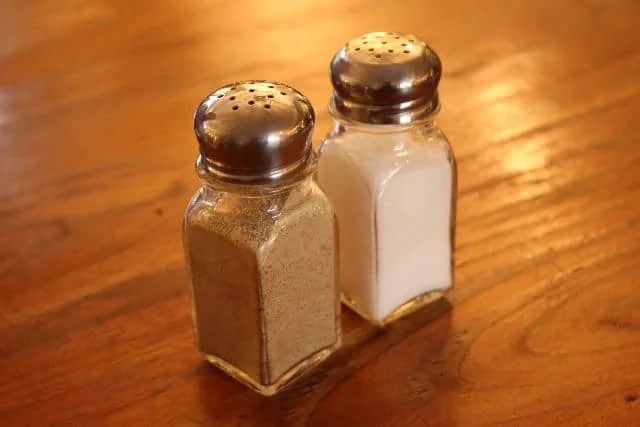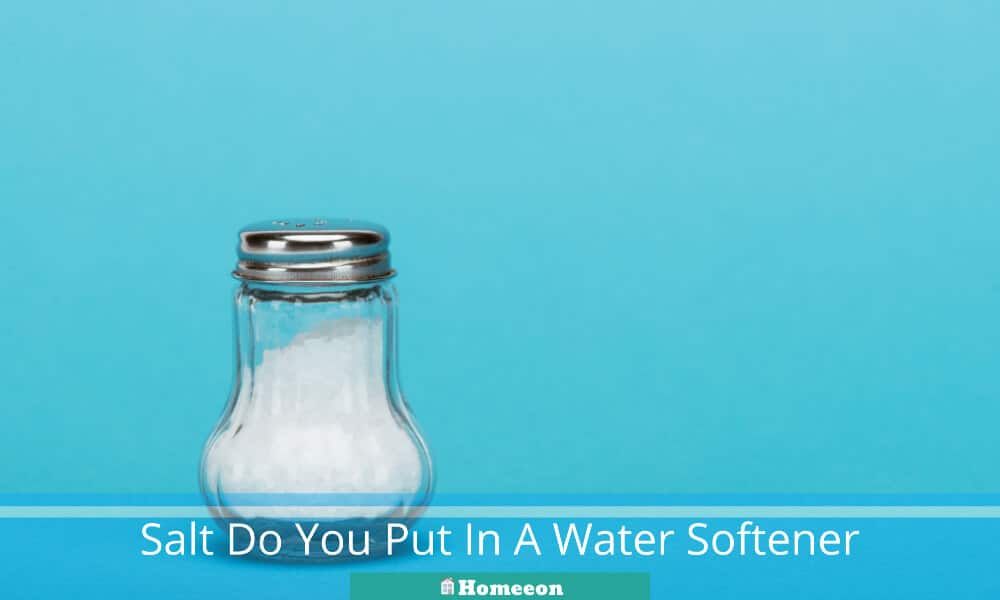Last Updated on August 14, 2023 By Emma W. Thomas
The amount of salt required for a water softener depends on its size and the hardness of your water. Generally, for a 32,000-grain capacity softener, add about 5 to 10 pounds of salt. Consult your softener’s manual for precise instructions tailored to your specific model.
How Much Salt Do You Put In A Water Softener?
The amount of salt one needs to add to a water softener depends on multiple factors. Here are some key points to consider:
1. Size of the Water Softener
The size of your water softener generally dictates how much salt it will need to function correctly. If your softener is large, it will require more salt.
2. Hardness of Your Water
Understanding the hardness level of the water source is crucial. Areas with harder water may need additional salt to offset the high mineral content.
3. Technology Used in the Softener
Softeners that use newer technologies often require less salt compared to older models.
4. Type and Quality of Salt Used
Water softener salts come in different types which include rock salt, solar salt, and evaporated salt. These types vary in purity and performance which could impact how much salt you need.
Here’s a general guide on how much salt you may need per month depending on your water softener size:
| Water Softener Size (Grains) | Salt Needed (lbs per month) |
|---|---|
| 16,000 | 8-10 |
| 24,000 | 10-15 |
| 32,000 | 15-20 |
| 48,000 | 20-25 |
| 64,000 | 25-30 |
5. Number of People in Your Household
The more water your household uses, the more often you will need to replenish the salt necessary for the water-softening process.
6. Regeneration Settings
The frequency of regeneration cycles can also impact how much salt is required. Some softeners have settings to regenerate based on a specific water volume or set timeframe.
In general, a well-functioning water softener should maintain a few inch’s worth of salt in the brine tank. In most cases, filling the tank halfway with salt is a good rule of thumb to ensure efficient operation without overfilling or underfilling.
It’s essential always to refer to your manufacturer’s instructions or contact a professional for more specific guidance based on your model and household needs. Regular monitoring and adjusting salt quantities as necessary is important for maintaining water quality and prolonging your water softener’s lifespan.
How Does A Water Softener Work?

For you to understand the importance of adding salt to your softener regularly, you need to know how things work. Water softeners have tiny resin beads or zeolite crystals that are negatively charged, and they hold on to positively charged ions. You need to add salt to your water softener for the beads to hold onto positive sodium ions. Hard water contains minerals such as calcium and magnesium, whose ions are positively charged. When hard water passes through the beads, the magnesium and calcium ions displace sodium ions and attach to the beads since they are stronger ions. When these ions are left on the beads, the resulting water is free from calcium and magnesium, making it soft water.
It is essential to note that softened water will contain sodium ions but will not be salty water. When all beads are full of magnesium and calcium ions, your water softener runs a cleaning and regeneration cycle, and that’s why you need to add salt. In this cycle, water is added to salt to form brine, which goes through the softener tank. At this stage, there’s a reverse ion exchange where mineral ions on the beads are replaced with sodium ions leaving these beads refreshed and ready for softening more water. Water containing hard minerals is then flushed out of the tank to the drain. This regeneration process takes place about once per week for most water softeners. Regeneration mostly happens when nobody is using water, especially at night.
What Is The Difference Between Traditional And Salt-Free Water Softeners?
Lately, we’ve seen the emergence of tankless or salt-free water softeners in the market. In case you’ve questioned how effective they are, we are here to help. Traditional water softeners use salt to remove the mineral ions, which cause hardness, thus leaving you with soft water. Saltless water softeners, on the other hand, condition these hard minerals by altering their structure. In essence, these softeners do not remove ions but reduce their impact.
If you want to keep using your appliances for a longer time and maintain the plumbing in your house, we recommend using a traditional water softener that uses salt. If you are looking for a temporary solution such as less scum when using soap, you can opt for saltless softeners.
Factors That Affect How Much Salt Your Water Softener Will Use
When researching how much salt you will need for your household, you need to consider a few factors. Every home’s need is different with different levels of water consumption. Here are some key pointers to how much salt you will use in your water softener:
1. Level Of Water Hardness
The more minerals your water has, the more salt you will use to soften it. Anything above 10.5 grains per gallon of hardness will require more salt since its above-average water hardness.
2. Size Of Your Family
Having more people in your house translates to more water consumption. If you have a larger family or use more water than average, you will need to add salt to your water softener more often. More water consumption will make your water softener regenerate more frequently, thus the need to add salt.
3. Type And Size Of Softener
A new water softener is more efficient than its older counterpart and may require more salt as it ages. Some systems also have larger tanks meaning they need more salt to function efficiently. A good practice is to ensure you always have a half-filled tank with salt. Doing this will ensure you still have soft water even between salt additions.
How Will I Know When My Water Softener Runs Low On Salt?
It is advisable to check salt levels in your water softener every week. You can use a salt monitor attached to your water softener, which alerts you when the brine needs more salt. If you do not have a monitor, you can check manually to ensure your salt tank is always above the half-full mark. When salt is less than half full, add more salt.
Water treatment experts recommend adding salt until the salt level is about 4 inches above the water level in the softener tank. If you cannot tell where the water level is, add salt until the brine tank is half full. You can opt to fill up your tank with salt but ensure you wait until the salt level goes low for you to refill. Refilling your tank without waiting for the salt level to drop is not recommended because it can cause salt to form lumps. Having clumps of salt in your brine tank might cause maintenance issues and block your brine well, resulting in hard water. The brine well is a tube with holes that allows water to flow in and out of the salt area to the brine wand. When it gets blocked, there’s less brine doing the cleaning, making some ions escape, and this results in hard water.
Best Salt For My Water Softener
Most water softeners have a manufacturer’s recommendation of the best salt to use. Ensure you read your user’s manual carefully for such instructions. You can also consult a water specialist before deciding on which salt to buy. The best salt for your water softener is one with the least impurities. You can choose between solar or evaporated salts and rock salts. Evaporated salts have a purity rate of up to 99% but are pricier compared to rock salts.
Debunking Common Water Softener Myths
Water softeners make life in areas with hard water easier and more convenient. Most homeowners appreciate water softeners, but some won’t use them because of what they’ve heard. There are some myths we need to bust about these gadgets for you to embrace them. Let’s dive right in!
1. Myth 1: Water Softeners Make Your Water Salty
Some people think that because these gadgets need the constant addition of salt, they make the water salty. It’s easy to assume that the salt goes into your water when you don’t know how a water softener works. As we discussed earlier, ion exchange takes place, and only sodium ions get into your water. If your water tastes salty after using a softener, you need to consult a technician since that could indicate a blockage.
2. Myth 2: Water Softeners Also Purify Water
Water softeners only remove ions that are responsible for water hardness and no impurities. If your water has sulfur, iron, or other impurities, you might need a filtration system before a water softener.
3. Myth 3: Water Softeners Are Expensive
You might need to part with a few bucks for an initial installation of a water softener, but in the long run, you end up saving a lot. Appliances such as water heaters consume a lot of energy when using hard water. Using a water softener makes work more comfortable and saves on electricity and costs you would have used to unclog or replace pipes. Soft water also needs less detergent when washing and keeps fabrics from fading. All these benefits, when taken into account, reveal how efficient water softeners are.
4. Myth 4: Softened Water Contains Unhealthy Amounts Of Sodium
Since water softeners work through ion replacement, sodium ions are left in soft water. Our nutrition expert says these amounts are not significant in our diet and cannot affect our health. If you are skeptical about sodium in your water, consider a water softener with a reverse osmosis system. This type removes sodium ions and purifies your water, making it safe and refreshing.
The Following Table Will Illustrate The Difference And Similarities Between Regular Salt And Iodized Salt.
| Similarities | Differences |
| 1) Appearance is similar to regular salt 2) Tastes the same as regular salt 3) Smell and texture are the same in both salts | 1) Iodized salt contains potassium iodate 2) Contains dextrose and anti-caking agents to avoid clumping and to prevent potassium iodide from getting evaporated |
Conclusion
Soft water helps us save on costs and comes with benefits such as longer-lasting appliances and pipes. Suppose your water contains calcium and magnesium; it is not all doom for you. You can invest in a water softener to enjoy the great benefits of soft water.
We hope you find this information helpful as you maintain or install your water softener.
References:
https://waterfilterguru.com/how-much-salt-do-you-put-in-a-water-softener/
https://www.discountwatersofteners.com/how-much-salt-do-you-put-in-a-water-softener/
Emma is a graduate of Domestic Science or Family and Consumer Sciences (Home Economics) from the University of Wisconsin. She has 7 years of experience Working with the strategic section of BestBuy and now writing full-time for Homeeon.
From Managing the Home, Interiors, Cleaning, and Exteriors to Gardening and everything about Making A Home Liveable – is her passion and this Homeeon is the result of this.
Emma loves decorating her home with the best stuff found online. She cares about quality over anything and writes reviews about them here in Homeeon. Get in touch with her over Pinterest.
Keep reading her blogs.

